Radiology Continuing Education Series
Course 3 of 6
Recording the Image
Course 1 – Physics of Radiology
Course 2 – Choosing the Appropriate Exposure Factors
Course 3 – Recording the Image
Course 4 – Poor Quality Films-Causes and Corrections
Course 5 – Radiation Safety-Importance and Procedures
Course 6 – Pros and Cons of Digital Radiography-CR vs. DR
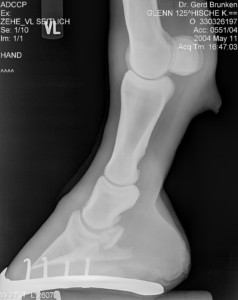
In previous session we have discussed how x-rays are produced in the Physics of Radiology and how that affects radiography quality in Choosing the Appropriate Exposure Factors. To further understand radiography it is important to understand how a permanent record is produced using x-rays.
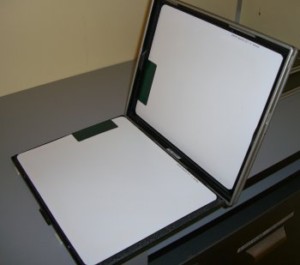 Radiographs are formed with light sensitive film contained in a lightproof encacasement, or cassette. The cassette holds a piece of double-emulsion x-ray film sandwiched between two fluorescent sheets of plastic called intensifying screens. The screens are mounted to the inside front and inside back of the cassette with adhesive. The film is then placed between the screens. When the cassette is closed a tight contact is created between the screens and the film, it is very important that this contact be maintained. Any increase in the distance between the screen and the film results in blurring of the image and degradation in image contrast. Any increase in the screen-film separation distance allows the light from the screen to spread, resulting in exposure of film that is undesired. A common cause of poor film-screen contact is warping of the cassette from dropping or other rough handling.
Radiographs are formed with light sensitive film contained in a lightproof encacasement, or cassette. The cassette holds a piece of double-emulsion x-ray film sandwiched between two fluorescent sheets of plastic called intensifying screens. The screens are mounted to the inside front and inside back of the cassette with adhesive. The film is then placed between the screens. When the cassette is closed a tight contact is created between the screens and the film, it is very important that this contact be maintained. Any increase in the distance between the screen and the film results in blurring of the image and degradation in image contrast. Any increase in the screen-film separation distance allows the light from the screen to spread, resulting in exposure of film that is undesired. A common cause of poor film-screen contact is warping of the cassette from dropping or other rough handling.
Intensifying Screens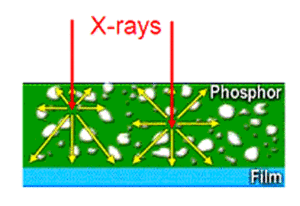
The x-ray film by itself is relatively insensitive to x-rays and takes a substantial number of x-rays to expose the film. X-ray film is actually much more sensitive to visible light. The intensifying screens convert the x-ray radiation into visible light creating the image on the film. More than 95% of the film exposure is due to the light emitted from the intensifying screen and only 5% as a result of the ionization of x-rays.
Intensifying screens are sheets of luminescent phosphor crystals bound together and mounted on a polymer or plastic base. Two screens are normally inside the cassette to sandwich the x-ray film, which has a coating of light sensitive emulsion on both sides (double emulsion). When 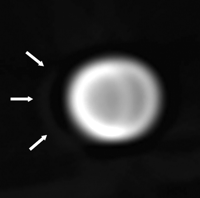 the phosphor crystals in the screen are struck by the x-ray, the crystals fluoresce converting it into visible light that exposes the film. For every x-ray absorbed by the screen multiple crystals are stimulated to give off light. The screen amplifies or intensifies the effect of the x-rays. Because of this effect, fewer numbers of x-rays are needed to create a given degree of blackness to the processed film. The main function of the intensifying screen is to reduce the amount of radiation exposure required to produce a radiograph. The use of screens result in lower miliamperage-seconds (mAs), thus decreasing the dose of radiation to the patient.
the phosphor crystals in the screen are struck by the x-ray, the crystals fluoresce converting it into visible light that exposes the film. For every x-ray absorbed by the screen multiple crystals are stimulated to give off light. The screen amplifies or intensifies the effect of the x-rays. Because of this effect, fewer numbers of x-rays are needed to create a given degree of blackness to the processed film. The main function of the intensifying screen is to reduce the amount of radiation exposure required to produce a radiograph. The use of screens result in lower miliamperage-seconds (mAs), thus decreasing the dose of radiation to the patient.
Four properties determine the efficiency of intensifying screens: high x-ray absorption, high x-ray to light conversion with suitable energy and color, there must be little or no “afterglow” once radiation has ceased, (afterglow is the tendency of phosphor to continue to give off light after the x-ray exposure has stopped), and the phosphor size and type, green, blue, rare earth or non-rare earth.
Five Main Factors of Screen Speed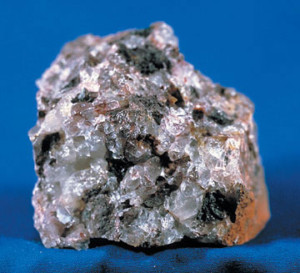
Screen speed is determined by chemical composition, crystal size, phosphor layer thickness, reflective layer efficiency, and dyes in the phosphor layer. Many different types of screens are available all of which are graded by their speed and efficiency.
The chemical composition of the screen is either calcium tungstate (CaWO4) or one of the several rare-earth phosphor combinations (gadolinium oxysulfide, lanthanum oxybromide, yttrium, oxysulfide). The major difference in the chemical composition affects the absorption and conversion efficiency.
The first phosphor intensifying screen was made of calcium tungstate was chosen for its emission of light in the blue regions of the ultraviolet spectrum. Calcium tungstate has a relatively high absorption ability and is physically strong, but is lacking in light conversion efficiency.
 In 1972, new phosphor technology developed the blue rare-earth system having greater speed. The rare earth group is also known as the lanthanide series because it consists of elements having atomic numbers 57 lanthanum through 71, lutetium. The x-ray to light conversion efficiency of rare earth phosphors is four times greater than that of calcium tungstate. The spectral emission of the newest rare earth phosphors is in the green light part of the visible spectrum. Because the standard x-ray silver halide film will not absorb as it is not sensitive to light in the green area, a special film that is sensitive to the green spectrum of light must be employed with this type of screen. Green rare earth screen/film systems are the most common system used in veterinary radiography today. The rare earth phosphors have both a higher absorption and conversion efficiencies than calcium tungstate, requiring fewer x-rays to produce the same amount of screen light resulting in shorter exposure times.
In 1972, new phosphor technology developed the blue rare-earth system having greater speed. The rare earth group is also known as the lanthanide series because it consists of elements having atomic numbers 57 lanthanum through 71, lutetium. The x-ray to light conversion efficiency of rare earth phosphors is four times greater than that of calcium tungstate. The spectral emission of the newest rare earth phosphors is in the green light part of the visible spectrum. Because the standard x-ray silver halide film will not absorb as it is not sensitive to light in the green area, a special film that is sensitive to the green spectrum of light must be employed with this type of screen. Green rare earth screen/film systems are the most common system used in veterinary radiography today. The rare earth phosphors have both a higher absorption and conversion efficiencies than calcium tungstate, requiring fewer x-rays to produce the same amount of screen light resulting in shorter exposure times.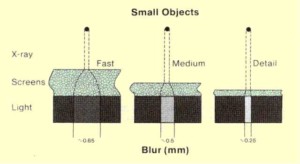
Screens are typically rated with a relative speed. A screen with 100 or par speed rating is the reference standard. A screen with a 200 speed rating would be twice as fast as the 100, requiring half the x-ray exposure to produce the same amount of light as was needed by the 100 speed. The 200 speed screen is also referred to as a fast screen. Slow screens are referred to as high definition and are made for high definition images where exposure time is not critical. Medium or regular is the most common speed of screen. They provide good resolution with relatively low exposures. Fast or high speed screens reduce exposure time or penetrate extremely thick tissue areas.
 Another way to change the speed of the screen is to change the size of the fluorescent crystals. The larger the crystal the greater its light emission is and less radiation is necessary to expose x-ray film. Unfortunately as the crystal size increases, the detail of the image decreases resulting in a grainy image. Smaller crystals produce more detailed images with higher amounts of radiation required.
Another way to change the speed of the screen is to change the size of the fluorescent crystals. The larger the crystal the greater its light emission is and less radiation is necessary to expose x-ray film. Unfortunately as the crystal size increases, the detail of the image decreases resulting in a grainy image. Smaller crystals produce more detailed images with higher amounts of radiation required.
The thickness of the phosphor layer also influences screen speed and image detail. With increased thickness the x-ray absorption and light emissions are increased yet the detail of the image is decreased, usually resulting in blurring from diffusion of the light as it travels through the screen.
A reflective layer positioned between the base and the phosphor layer of the screen made up of a white substance such as 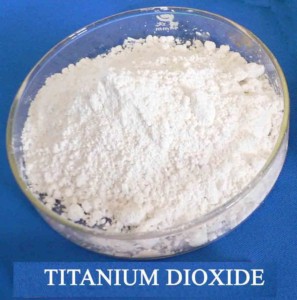 titanium dioxide, reflects the light emitted by the phosphor layer to the x-ray film. If the reflective layer contains light absorbing material, a portion of the light produced by the phosphors will be lost. It is important that the reflective layer material has a high reflective capability and a low absorption capacity.
titanium dioxide, reflects the light emitted by the phosphor layer to the x-ray film. If the reflective layer contains light absorbing material, a portion of the light produced by the phosphors will be lost. It is important that the reflective layer material has a high reflective capability and a low absorption capacity.
Light absorbing dyes may be incorporated in the binding material of the phosphor layer of some screens, to decrease lateral spreading of the light emitted by the phosphor crystals, reducing blurring of the image. However this can also reduce light intensity emitted by the screen decreasing screen speed. Common dyes used are yellow, gray, and pink.
Common Screen Types
The following are the most common screen types:
Rare Earth Green Screens – These most popular green emitting regular and 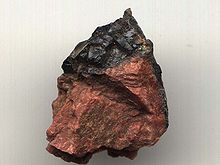 asymmetric screens utilize the rare earth phosphor Gadolinium Ox Sulfide, for use with orthochromatic, green sensitive film. Speeds: green 600, 400, 200 and 50.
asymmetric screens utilize the rare earth phosphor Gadolinium Ox Sulfide, for use with orthochromatic, green sensitive film. Speeds: green 600, 400, 200 and 50.
Rare Earth Blue Screens – These blue emitting screens developed in the 1970’s are made with rare earth phosphors for use with blue sensitive film. Speeds: blue 800, 400, and 100.
Calcium Tungstate – These screens are manufactured using carefully selected and controlled calcium tungstate phosphors applied to a polyester base. Speeds: high plus 200, medium 100 and fine 50
Screen Care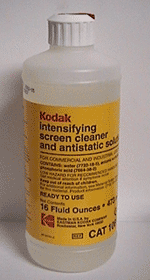
The importance of screen care cannot be minimized. They should be inspected and cleaned on a regular basis to keep dust and animal hair from causing poor quality images. Any abrasion, chemical spill or artifact will be noticed on film images.
Clean screens according to manufacturer’s instructions with commercial screen cleaner, which have antistatic properties. After cleaning leave cassette open and propped up in the vertical position to dry before reloading. The vertical position prevents dust or hair from settling inside cassettes. Avoid touching the screens or writing on film that is still in the cassette. Damages to screen surfaces are permanent and cannot be repaired.
X-ray Film
X-ray film is composed of a layer of sensitive emulsion coated onto a plastic base. The emulsion can be coated on a single side or on both sides of the base, called single emulsion or sometimes detail film or double emulsion film. The sensitive layer of the emulsion is a silver compound, usually silver bromide (AgBr), also known as, silver halide. When the visible light or ionizing radiation of the x-rays interacts with the silver halide crystals an invisible image is formed. As the silver halide crystals absorb energy from visible light or x-rays, a physical change occurs and a latent image is formed. During chemical processing the silver bromide is reduced to elemental silver, which is black forming the radiograph. The unexposed silver halide crystals are cleared off the film during the fixing portion of the processing, leaving a clear image.
X-ray film can be used alone (non-screen film) in a light-proof container or more typically with intensifying screens (screen film).
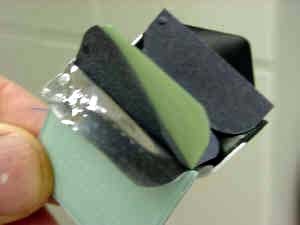 Non-screen film is exposed by the direct action of x-radiation. This type of film is manufactured to be more sensitive to ionizing radiation and requires greater exposures. The best example of film being used without screens is dental film. Because intensifying screens are not used, there is no loss of detail due to the screens and images have great detail. Because of greater exposure, non-screen films should be used only for areas where tissue thickness is minimal.
Non-screen film is exposed by the direct action of x-radiation. This type of film is manufactured to be more sensitive to ionizing radiation and requires greater exposures. The best example of film being used without screens is dental film. Because intensifying screens are not used, there is no loss of detail due to the screens and images have great detail. Because of greater exposure, non-screen films should be used only for areas where tissue thickness is minimal.
Screen film is manufactured with silver crystals that are naturally sensitive to fluorescent light in the ultraviolet-blue wavelengths emitted from intensifying screens and less sensitive to ionizing radiation, requiring less exposure. Screen film for many years has primarily been blue sensitive. Newer films have now been developed that are green sensitive, used with rare earth screens. The rare earth screens emit stronger narrower bands of light. Depending on the chemical composition of the rare earth phosphors, the strong bands of emissions range from blue to green. The films silver bromide crystal, with a dye that is sensitive to green light is called orthochromatic film. If you are to take full advantage of the increased light emission from the rare earth screens, it is very important to match the screen emission to the film’s absorption sensitivity.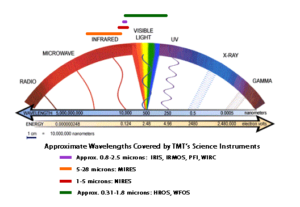
Film is manufactured with various speeds by using different sized silver halide crystals. Speeds of film are determined from the exposures required to produce an image with adequate density. The exposure range over which acceptable densities are produced is film latitude. Film that has a wide latitude will accept a significant variation in exposure factors or processing without exhibiting a great change in density. Narrow latitude or high contrast film requires considerably less change in exposure factors or processing to alter the radiographic density.
There are three basic groups of film speed. Fast film or ultra speed has larger silver halide crystals, requires less exposure, produces grainier images that lack definition and has less latitude. Medium or standard film is the most widely used, and is a compromise between fine grain and speed for a wide range of examinations and has medium latitude. Slow film or high detail film has smaller silver halide crystals, requires greater exposure, produces images with high definition and has greater latitude.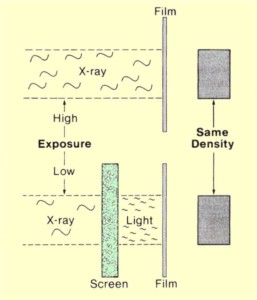
Film handling and storage is of great importance. Store boxes so film is vertical so the emulsion on each sheet doesn’t bleed together. Store in cool area (50 to 60 degrees Fahrenheit) with low humidity (40% to 60%). Excessive heat and humidity result in softening of the emulsion causing film to stick together and decreases shelf life. Do not store film near sources of radiation or fumes from formalin, hydrogen peroxide or ammonia which will fog the film.
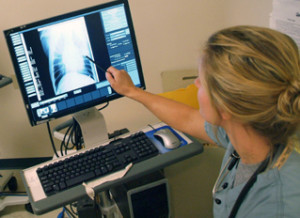 Knowledge of the film-screen combination is vital. The combined speed otherwise known as system speed is what determines the exposure requirements, which we discussed in Choosing the Appropriate Exposure Factors.
Knowledge of the film-screen combination is vital. The combined speed otherwise known as system speed is what determines the exposure requirements, which we discussed in Choosing the Appropriate Exposure Factors.
